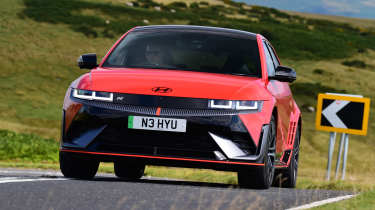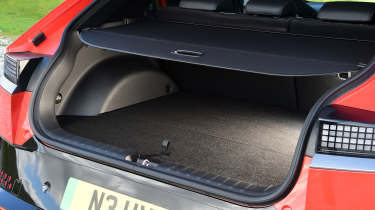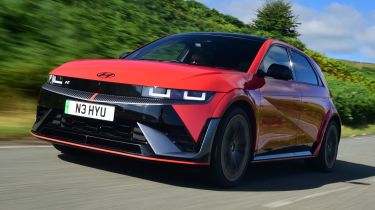Hyundai Ioniq 5 N review
The Hyundai Ioniq 5 N really is the first electric vehicle that can be considered a true driver’s car

Our opinion on the Hyundai Ioniq 5 N
You can legitimately consider the Hyundai Ioniq 5 N as the first electric vehicle that’s a true driver’s car. While obvious electric rivals include the Ford Mustang Mach-E GT and Tesla Model 3 Performance, the Ioniq 5 N deserves to be fighting against more traditionally powered competition as distinguished as the brilliant BMW M3 Competition.
With revisions to the electric powertrain and software, along with extensive changes to the chassis, the N transformation lies so much deeper than just a menacing bodykit and a set of striking 21-inch forged aluminium wheels, which is why we named the Ioniq 5 N our 2024 Performance Car of the Year, and it continues to be highly commended in our 2025 Car of the Year awards.
| Key specs | |
| Fuel type | Electric |
| Body style | Crossover |
| Powertrain | 84kWh battery, 2x e-motor, four-wheel drive |
| Safety | Five stars Euro NCAP (2021) |
| Warranty | Five years/unlimited miles |
About the Hyundai Ioniq 5 N
Since it’s the flagship of the range, the Hyundai Ioniq 5 N doesn’t come cheap, starting from around £65,000. That’s the best part of £10,000 more than the priciest version of the regular Ioniq 5 range, but it’s arguable that it’s well worth the extra for the performance enhancements and additional visual aggression that come with the tweaks made by Hyundai’s N performance division.
As with the standard Ioniq 5, there’s just one body style for the Ioniq 5 N, which has the looks of a five-door hatchback, but with dimensions that mean it’s longer and wider than the Hyundai Tucson SUV. For this reason, we classify it as a crossover, since it doesn’t resemble an SUV, especially with the N performance upgrades.
There’s just one powertrain option, with an 84kWh battery powering two electric motors that provide four-wheel drive and a total output of 641bhp. The Ioniq 5 N has direct drive like the rest of the range, but Hyundai has added a simulated eight-speed gearbox designed to deliver the sensation of driving a car with a twin-clutch transmission.
Hyundai quotes an official range of 278 miles, which is the poorest of any Ioniq 5 fitted with the 84kWh battery, and is only five miles more than the entry-level 63kWh version of the car can achieve. Clearly, performance comes at the expense of efficiency, but that’s an accusation that you can level at any performance car, whether powered by electric, hybrid or a combustion engine.
If you're interested in getting yourself a Hyundai Ioniq 5, we can help. Configure your ideal Hyundai Ioniq 5 N now to get top offers from local dealers, check out the latest Hyundai Ioniq 5 N leasing deals, or search for used Hyundai Ioniq 5 N models with our Find A Car service. You can even sell your existing car for a great price with Auto Express Sell My Car.
Electric motor, performance & drive

|
Pros |
|
| Cons |
|
There’s an awful lot more to the Ioniq 5 N than just its huge power numbers. There are so many settings to play with that some drivers might feel a little bewildered at first. But take some time to come to an ideal set-up for the adaptive dampers, electric drive motors, steering response, electronic limited-slip differential (e-LSD) on the rear axle, and stability control, then program it into one of the two N button shortcuts on the steering wheel, and you can tailor the car to respond exactly how you want it to.
Those user-definable settings even stretch to a mode that simulates the sound of an internal-combustion engine, and there’s also the ability to make the power delivery simulate the transmission shunts of a dual-clutch automatic gearbox.
One thing is clear: as it stands, the Ioniq 5 N blows any other performance EV clean out of the water for driver involvement, poise and excitement. It’s the first fully electric vehicle that actually deserves to be talked about in the same breath as super-saloons (and estates) such as the BMW M3, Alfa Romeo Giulia Quadrifoglio and the Audi RS 4 Avant.
That will be a surprise to anyone who has tried the standard Ioniq 5, which is a hugely relaxing but rather soft and wayward car to drive. The transformation from that model to the N is profound. It starts with the body, whose rigidity is boosted by 42 extra welding points and 2.1 metres of extra bonding. Beyond that, the battery and motor mounts, subframes and steering column have all been toughened, while the axles are also stronger yet lighter.
Even at low speeds, the extra attitude of the N is immediately obvious. The suspension is much firmer than the standard Ioniq 5’s, yet it’s supple in a way that suggests some serious engineering expertise is at work. Being an EV, it’s dead easy to drive at low speeds, with a throttle and brake pedal that are simple to modulate.

It’s out on more open roads where the Ioniq 5 N does its best work. We have never driven an electric vehicle before that feels so connected to the tarmac, that involves the driver as much or provides so much excitement when you’re behind the wheel. In terms of responsiveness, agility and excitement, the Ioniq 5 N really is up with the best five-seat performance cars around.
The e-LSD works wonders for the Hyundai’s balance, particularly if you adjust the torque distribution a little further rearwards using the drive modes. If you do this, it’s really quite mind-blowing how easy it is to play with the car’s balance, even engaging some slip from the rear tyres, while it remains so approachable.
That adjustability continues off the throttle, too. Lift mid corner, and the weight transfers towards the front axle, helping the nose tuck in a little further. It’s all backed up by that stunning straight-line speed, which launches the Ioniq 5 N out of one corner as it charges towards the next. Throttle response is instantaneous, yet there’s enough travel in the right pedal to cleanly modulate your inputs.
That all of this is achieved without unduly compromising the ride quality is all the more astounding. Yes, the firmer two of the three suspension settings aren't what we’d settle for in everyday driving (although even the firmest option becomes only a touch fidgety rather than overtly harsh), but the most relaxed set-up feels positive, controlled and well judged for a twisty B-road. The Hyundai certainly rides better than a Ford Mustang Mach-E GT, but it’s also more compliant than a BMW M3, if not quite as effective at rounding off rough edges as an Alfa Romeo Giulia Quadrifoglio.
For the most part, the Ioniq 5 N does a stunning job of disguising that it weighs 2.2 tonnes. However, there is one area where the Hyundai can’t overcome the laws of physics, and that’s under braking. Hard stops are a slightly hair-raising experience despite the car’s enormous front brake discs, and we’d have a bit more confidence if the left pedal offered a little more initial bite, too.
At higher speeds, that weight, width and stability all work in the Ioniq 5 N’s favour. Combined with a ride that comes into its own and the spacious cabin, it really is quite a relaxing place to be on a motorway cruise.
Performance, 0-60mph acceleration and top speed
In general, electric powertrains are fairly straightforward: in simple terms, there will be a motor (or several) paired with a battery. In the case of the Ioniq 5 N, there are two motors in its 800-volt electrical architecture, one up front making 223bhp and another at the back producing 378bhp, both of which are integrated into the axles to boost strength.
That maximum power comes to 601bhp, but if that’s not enough, the overboost button on the steering wheel brings the combined output to 641bhp and 740Nm of torque. That is sent to all four wheels to deliver a supercar-baiting 3.4-second 0-62mph time, and it can go on to a top speed of 161mph, which is significantly higher than the standard Ioniq 5.
“Hearing the engine rev is a key part of driving quickly – something that is missing from EVs. The Ioniq 5 N can simulate the sound of an engine and limits the torque during ‘gear changes’ to give the sensation that power is going through an eight-speed dual-clutch gearbox. I’ll admit that before trying this, I was prepared to hate it, but it works so well that you almost forget that you’re driving an EV at all.” – Alex Ingram, Chief reviewer
| Model | Power | 0-62mph | Top speed |
| Ioniq 5 N | 641bhp | 3.4s | 161mph |
Range, charging & running costs
|
Pros |
|
| Cons |
|
Electric range, battery life and charge time
Officially, Hyundai claims the Ioniq 5 N will cover 278 miles on a single charge of its 84kWh battery, but even in ideal weather conditions for an EV, we found that closer to 220 miles was a more realistic figure when we tested it. At least that range can be replenished quickly, because a 10-80 per cent charge (which adds about 154 real-world miles) can take as little as 18 minutes. If you’re charging from a 7.4kW AC source at home, expect the battery to be fully charged in around 11.5 hours.
Thanks to a Benefit-in-Kind (BiK) rate of just three per cent, the Ioniq 5 N is significantly more affordable for a higher-rate income taxpayer than traditional performance cars, such as the Alfa Romeo Giulia Quadrifoglio and BMW M3. However, electric vehicles like the Ioniq 5 N are no longer eligible for free vehicle excise duty (VED), also known as road tax. Also, because the Ioniq 5 N costs more than £40,000 when new, you’ll need to pay an additional luxury car tax surcharge above the standard VED rate from the second time the car is taxed, up until it is six years old.
Electric vehicles have a reputation for strong depreciation, but it’s one that’s only deserved for those models that are overpriced in the first place. The Ioniq 5 N is a bit of a bargain for the performance on offer, which is reflected in its strong residuals. It will retain 56 per cent of its original value after three years. That’s better than similarly priced hot EVs such as the Ford Mustang Mach-E GT (38 per cent), but also performance saloons, like the BMW M3 (47 per cent).
| Model | Battery size | Range | Insurance group |
| Ioniq 5 N | 84kWh | 278 miles | 49 |
Design, interior & technology

|
Pros |
|
| Cons |
|
Hyundai says that inspiration for the Ioniq 5’s design came from the Hyundai Pony Coupé, which was unveiled in 1974. Giorgetto Giugiaro shaped that car, but it’s another of the legendary designer’s creations – the Lancia Delta, particularly in rally-bred Integrale form – which springs to mind in the Ioniq 5’s transformation to full-fat N spec.
The striking body is enhanced by a dramatic front bumper, deep side skirts and an enlarged rear diffuser. Soutronic Orange is the standard colour which stands out particularly well, as does N division’s Performance Blue, which is available in matte and gloss finishes at extra cost.
The retro-modern look has squat hot-hatch proportions (even though, at 4.7 metres long and almost 1.6 metres tall, it’s too big to be classed as a hot hatch), and is just overflowing with purpose and menace from every angle. If fans of performance cars are looking for visual drama, they won’t feel short-changed.
Inside, the cabin gets a moody black finish that is punctuated by subtle highlights in the brand’s Performance Blue shade, and glowing N logos on the seats. The steering wheel is unique to the N version and features shortcut buttons to activate drive modes programmed by the driver via the main touchscreen. The overall interior finish feels reasonable, if not outstanding for a £65k car.
A 12.3-inch digital instrument cluster sits ahead of the driver. This can display a range of performance parameters, including G-meter, electric motor, and battery temperatures, as well as the current settings for the adaptive dampers and steering. A big tachometer sits in the centre, which becomes a rev counter when the simulated internal combustion engine mode is selected.
An eight-speaker Bose sound system is fitted as standard, which is great for music when it’s not piping in sound effects that emulate a four-cylinder turbo motor or a jet engine.
Sat-nav, stereo and infotainment
We’ve often praised Hyundai’s infotainment systems in the past, and the Ioniq 5 gets several N-specific menus to help the driver dive into its intricate settings.
The N page within the 12.3-inch central touchscreen allows direct access to some of the most important factors, including the ability to adjust the torque distribution front to rear, engage Race Mode, and view a lap timer, plus throttle and pedal traces, in real time. It’s all fairly easy to figure out, but it’s the sort of thing that is best adjusted when the car is standing still.
“Certain areas, such as the huge, bare door panels, just hint at a little cheapness in places. And while the switchgear feels fairly well-damped, it doesn’t operate with the solidity of premium performance cars around this price point” – Alex Ingram, Chief reviewer
Boot space, comfort & practicality
|
Pros |
|
| Cons |
|
The Ioniq 5 N has a great set of sports seats that offer plenty of very necessary lateral support for cornering. But the front seats that are so aggressively bolstered work best when their base is almost level with the pedals, while the taller Ioniq 5 has a near-SUV like driving position. This means the seating layout never quite feels right; a lower base, or even raised pedals, would make the driver feel even more involved in the action.
Rear visibility is boosted by the fact that, unlike early Ioniq 5 models, the N gets a rear window wiper as standard.
Passengers further back don’t get such extreme seats. Instead, they have the same bench that you’ll find in the rest of the Ioniq 5 range, only trimmed in grippy Alcantara. The key thing here is that there is a huge amount of kneeroom and a completely flat floor, so there's plenty of foot room for three people to sit in the back. Rear headroom is merely fine rather than exceptional, while the flat seat base doesn't give great under thigh support.
The rear windows let in plenty of light, but built-in retractable blinds help to keep things cool if you have little ones in the back. In keeping with the regular Ioniq 5, there are ISOFIX child seat mounting points on the outer positions of the rear bench.
| Dimensions | |
| Length | 4,715mm |
| Width | 1,940mm (2,152mm inc mirrors) |
| Height | 1,585mm |
| Number of seats | 5 |
| Boot space | 480 - 1,585 litres |
Dimensions and size
Much like the regular Ioniq 5, the hatchback styling of the Ioniq 5 N makes you assume this is more on par with an Audi RS3 or Mercedes-AMG A45 in terms of size. However, at 4,715mm in length, it’s closer in size to a Ford Mustang Mach-E GT. Be wary of width restrictions, too, because at 1,940mm in width (2,152mm with the mirrors), it’s significantly wider than the Ford.
Boot space
It seems as if most of the car’s packaging has been focused on providing space for people, rather than their luggage. A 480-litre volume is fine, but we’d hope for a bit more capacity in a car of this size. While the area the boot covers is very large, a high floor means that the load bay is also shallow.

“The Ioniq 5 N boast an identical 480 litres of boot space as the Giulia Quadrifoglio, but the hatchback bodystyle of the 5 N makes this space more usable, while passengers in the back will appreciate the huge rear knee room, wide rear bench and flat floor - especially compared to the snug confines of the Alfa.” – Alex Ingram, Chief reviewer
Safety & reliability

|
Pros |
|
| Cons |
|
Hyundai came 20th out of 31 brands in our 2025 Driver Power satisfaction survey, ranking it above Ford (23rd) but well behind other performance car manufacturers, such as BMW, which ranked eighth.
The Ioniq 5 scored a five-star Euro NCAP rating when it was tested in 2021, and all versions of the Ioniq 5 N feature blind spot monitoring with a camera feed displaying what’s alongside when you indicate. It also features a highway driving assistance system, which helps keep the car centred in your lane while driving along a dual carriageway or motorway – although it's not a self-driving system, and you'll still need to keep your hands on the wheel at all times.
| Key standard safety features |
|
| Euro NCAP safety ratings |
|
Buying and owning
Our best buy: Hyundai Ioniq 5 N
There’s only one version of the Ioniq 5 N, so the only options you have are the choice of exterior colour and whether you want it with the £1,500 panoramic glass roof. The latter can help brighten the rather black interior, while we’d be inclined to stick with the standard Soultronic orange pearl metallic paint. Performance blue in either gloss or matte is nice, but we think the orange suits the Ioniq 5 N well.
All Hyundais have a five-year, unlimited-mileage warranty, which is a rare perk in a car with as much performance as the Ioniq 5 N.
Electric running gear delivers searing performance, but maintenance costs are significantly lower than those of a highly strung combustion engine setup. A major check-up costs around £167, with interim services about half as much, so three years’ maintenance comes to only £302.
Hyundai Ioniq 5 N alternatives
The Hyundai Ioniq 5 N is in a unique position as one of the first genuine driver’s electric cars on the market. Obvious EV rivals include the top-spec Ford Mustang Mach-E GT, Kia EV6 GT (which shares similar running gear with the Ioniq 5) and the Tesla Model 3 Performance, but none are as fast or handle as sweetly.
To match the Ioniq 5 N’s acceleration, you’d have to look at the more expensive BMW i4 M50 or Mercedes-AMG EQE 53, but again, the Hyundai is a better driver’s car than both.
Look beyond EVs, and there is some serious performance car opposition on hand, including the BMW M3 Competition (also available as an even more family-friendly BMW M3 Touring estate, of course), Audi RS 4 Avant and Alfa Romeo Giulia Quadrifoglio, all of which are able to raise a smile courtesy of their high-performance petrol powertrains.
Deals on the Hyundai Ioniq 5 N and alternatives
Hyundai Ioniq 5 N pictures
Frequently Asked Questions
As with all Hyundais, the high-performance Ioniq 5 N has a five-year, unlimited mileage warranty in the UK.




